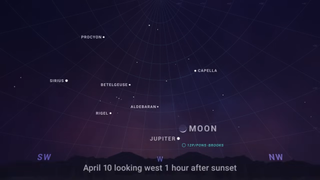
A NASA sky map showing the location of Jupiter near the crescent moon 1 hour after sunset on April 10, 2024.
(Image credit: NASA/JPL-Caltech)
In an unofficial sense, I would like to dub today (April 10) as “View a Planet Day.”
In the early morning hours will be two planets that will appear very close to each other and then later that same day, in the early evening sky we’ll have a chance to see Jupiter hovering near to a slender waxing crescent moon, making for a rather eye-catching sight. And there will be other celestial objects out there to see and find as well among the brightest planets in the night sky.
Here are some interesting details concerning these upcoming get-togethers.
Mars and Saturn
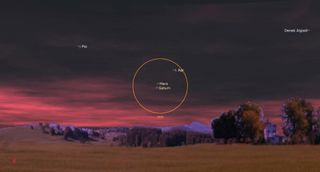
This sky map shows the location of Mars near Saturn in the night sky on April 10, 2024. (Image credit: Chris Vaughan/Starry Night)
These two “superior” planets — planets whose orbits are farther out from the sun compared to the Earth — are currently visible about 30 to 40 minutes before sunrise, low near the east-southeast horizon. Binoculars will certainly help in locating them against the brightening twilight sky.
Both planets will be practically the same in brightness, separated by just a mere .02 magnitude. Saturn, the brighter (magnitude +1.14) will shine sedately below Mars (magnitude +1.16), the two worlds being separated by just a half-degree, which is equal to the apparent width of the moon. (The actual closest approach to each other, a little over four-tenths of a degree, comes after sunrise for much of North America.) If unsettled weather denies you a view of this duo on Wednesday, April 10, they’ll appear almost the same distance apart on the following morning, though Mars will have shifted to the upper left of Saturn.
If you use a telescope equipped with a low-power eyepiece you’ll be able to fit both planets into the same field of view. Along with the fact that they’re virtually the same brightness, their contrast in colors is quite striking, with Mars glowing with a pumpkin hue compared to the golden-yellow Saturn.
A pattern to these meetings
Saturn, at a mean distance of 886.2 million miles (1.42 billion km) from the sun, takes 29.46 years to move once around the sun. While Mars, at a mean distance of 141.6 million miles (227.8 million km) from the sun, requires only 1.88 years to complete one journey around the sun. As a result, Mars’ normal eastward motion among the stars is considerably faster than that of Saturn. As such, from our vantage point here on the Earth, Mars will periodically seem to overtake Saturn in the sky.
Breaking space news, the latest updates on rocket launches, skywatching events and more!
Interestingly, when we combine the motions of Earth, Mars and Saturn, we find that the interval between Mars-Saturn conjunctions averages about every 2 years and 7 days. In the table below, we list all of these conjunctions from 2018 to 2030. Take note that the upcoming conjunction will be the second closest during this twelve-year interval (although practically as close as the one in 2022).
Swipe to scroll horizontally
Mars-Saturn Conjunctions: 2016-2030DateSeparationApril 2, 20181.3 degreesMarch 31, 20200.9 degreesApril 5, 20200.37 degreesApril 10, 20240.43 degreesAprl 19, 20261.2 degreesApril 30, 20281.8 degreesMay 16, 20302 degrees
Jupiter sides with a crescent moon
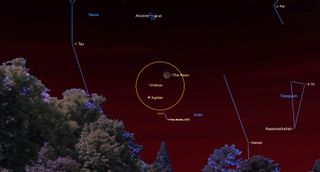
This sky map shows the location of Jupiter near the crescent moon 1 hour after sunset on April 10, 2024. (Image credit: Chris Vaughan/Starry Night)
It will soon be time to bid a fond adieu to an object that has been a fixture in our evening sky since mid-autumn: the planet Jupiter.
Jupiter is leaving our skies after many months of impressive display. Currently, it’s setting about two hours and 20 minutes after the sun and you can still see it quite easily, albeit rather low in the western sky as early as 30 to 40 minutes after sunset. It’s the brightest “star” in the area.
On Wednesday evening we’ll be treated to a lovely celestial tableau, as a very narrow crescent moon, 2.3 days past new phase (and the solar eclipse) and a mere 7-percent illuminated, sits about 4 degrees to the lower left of Jupiter. Remember that your clenched fist, held at arm’s length measures roughly 10 degrees. So, Jupiter and the moon will appear to be separated by a little less than half a fist. The slender sliver of the moon, tilted a bit to the right, will almost seem to mimic the grin of the invisible Cheshire cat from Lewis Carroll’s “Alice’s Adventures in Wonderland.”
Eye-catching Earthshine!
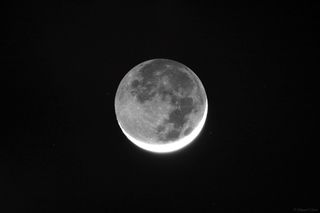
Miguel Claro sent Space.com this beautiful image of the moon and Earthshine taken from Almada, Portugal on Feb. 1, 2014. (Image credit: Miguel Claro | www.miguelclaro.com)
Be sure to check out the moon to see if you can see the phenomenon known as “Earthshine,” more popularly known as “The old moon in the new moon’s arms.”
This is light which has traveled from the sun to the Earth and reflected back up toward the moon and then back to the Earth — a “treble trip.” Binoculars will bring out this effect better than with just your naked eye. Earthshine is rather faint because only a small part of the sunlight reflected from the Earth hits the moon. The moon, because it’s such a poor reflector, reflects only 7 percent of this into space again, and only a small fraction of this makes it back to Earth. In binoculars, the effect can be quite striking; the moon appears as an eerie yellow and bluish-grey ball, almost three-dimensional.
Now add Jupiter, shining like a silvery jewel to the moon’s upper right and you’ll have a truly eye-catching sight. And as a bonus, the beautiful Pleiades star cluster will glitter 8-degrees above the moon. Just make sure that your western sky is free from any obstructions like nearby buildings or trees so that you can take it all in with a single glance.
And maybe a comet too!
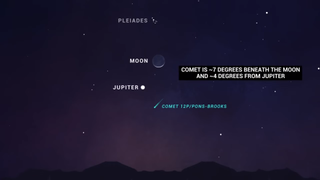
This NASA sky map shows the location of Comet 12P/Pons-Brooks near Jupiter and the moon just after sunset in early April 2024. (Image credit: NASA/JPL-Caltech)
And if nature is in a show-off mood, there is yet one other object you might try to find. That would be comet 12P/Pons-Brooks, which will be situated about 6 and a half degrees below the moon and 4 degrees to the lower right of Jupiter.
The comet should be near its peak brightness now, at magnitude +4.6; perhaps dimly visible with the unaided eye from a dark location, but certainly accessible with a good pair of binoculars or a small telescope. Visually, the comet should appear as a circular, wispy patch of light with possibly a faint gas tail protruding upward and to the left of its little bright end (the comet’s head).
Farewell for now
With each passing evening, Jupiter will drop a little lower into the sunset glow. By April 23, the difference between sunset and Jupiter set will diminish to 90 minutes. By April 30, Jupiter will stand only 5 degrees above the western horizon a half hour after sunset. The big world goes down just over an hour after the sun and is becoming increasingly difficult to see in the bright twilight glow.
By May 4, Jupiter will be gone. It will be in conjunction with the sun on May 18, transitioning into the morning sky, where it will reappear at dawn early in June.
So, for Jupiter this is not really a “goodbye,” but only a “farewell” until later in the spring. As American writer, Richard Bach so aptly put it:
“Don’t be dismayed at goodbyes. A farewell is necessary before you can meet again.”
Editor’s Note: If you snap an amazing photo of Jupiter, the moon, Saturn or Mars, and would like to share it with Space.com’s readers, send your photo(s), comments, and your name and location to [email protected].
Joe Rao serves as an instructor and guest lecturer at New York’s Hayden Planetarium. He writes about astronomy for Natural History magazine, the Farmers’ Almanac and other publications.
Join our Space Forums to keep talking space on the latest missions, night sky and more! And if you have a news tip, correction or comment, let us know at: [email protected].
Joe Rao is Space.com’s skywatching columnist, as well as a veteran meteorologist and eclipse chaser who also serves as an instructor and guest lecturer at New York’s Hayden Planetarium. He writes about astronomy for Natural History magazine, the Farmers’ Almanac and other publications. Joe is an 8-time Emmy-nominated meteorologist who served the Putnam Valley region of New York for over 21 years. You can find him on Twitter and YouTube tracking lunar and solar eclipses, meteor showers and more. To find out Joe’s latest project, visit him on Twitter.
>>> Read full article>>>
Copyright for syndicated content belongs to the linked Source : Space.com – https://www.space.com/jupiter-crescent-moon-mars-saturn-night-sky-april-10-2024































